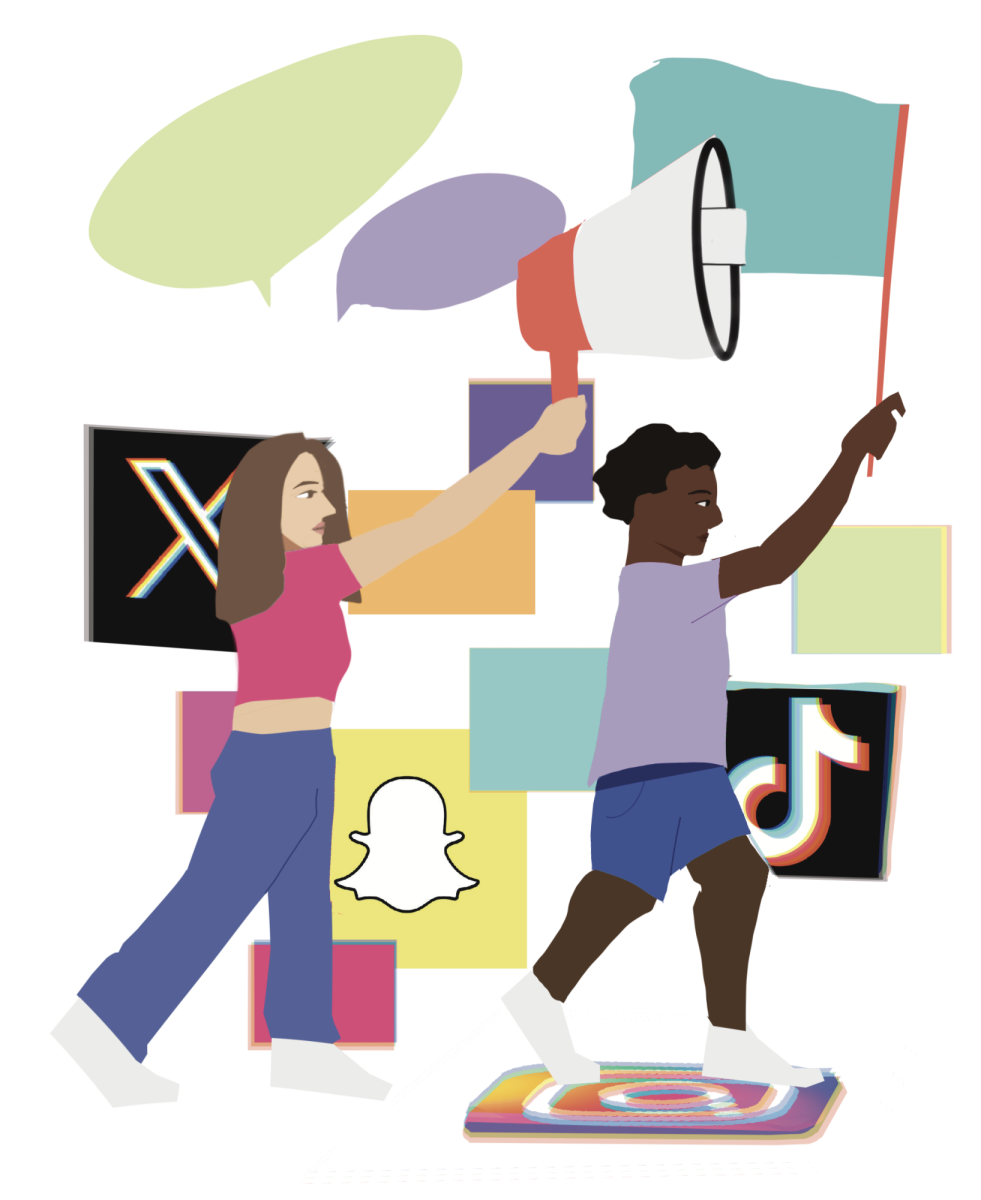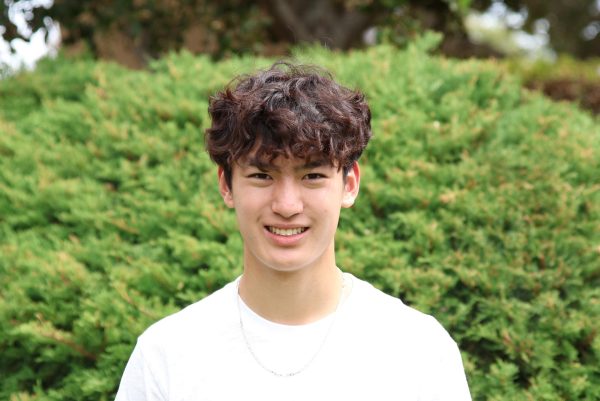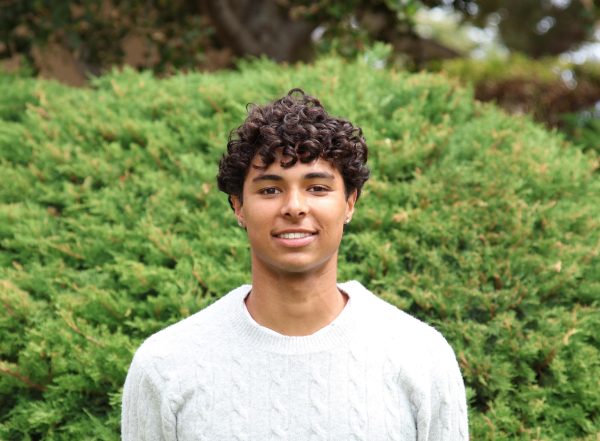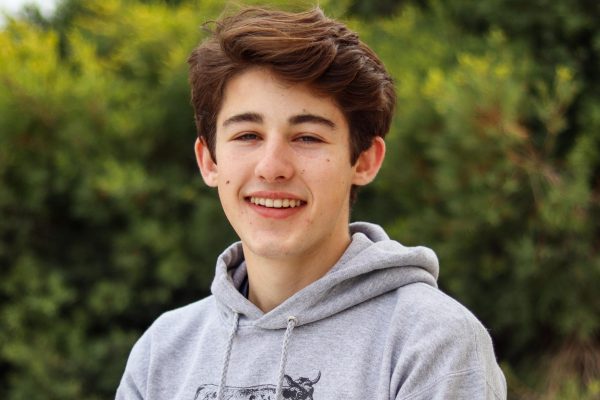As a sophomore in Portland four days before Earth Day, Kofi Kim opens Instagram and instantly, a colorful flood of posts fills his screen. Tapping to view a story from his school’s environmental club, words promoting Portland Youth Climate Strike’s upcoming protest popped out at Kim, now a Paly junior, telling him and Oregon Episcopal School students, “FILL OUT THE INTEREST FORM IN OUR BIO!”
A few days later, the sidewalk beneath Kim trembles as footsteps march across the streets of Portland for the Youth Climate Strike. Waving flags, jovial chants and colorful signs paint the scene, with roars of the crowd echoing throughout the city.
This is the power of social media, and Generation Z has not hesitated to embrace it.
Background
Generation Z, or Gen Z for short, includes those born between 1997 and 2012 –– the first generation to grow up with access to portable technology and the internet, shaping countless aspects of their lifestyle and culture and not always for the better.
Dr. Roberta Katz, Emerita, Associate VP and Senior Research Scholar at Stanford, said social media can create disorder, which can impact the perception and circulation of politics and activism movements in particular.
“We’re in a time of big social change, which is not unusual because we’ve gone through big technological change,” Katz said. “And social change at this scale can create chaos and upheaval. While social media is a way that you can get news, it is bigger than just that.”
Katz said unlike past generations, growing up in the digital age has given Gen Z access to unprecedented amounts of information, simultaneously polarizing and connecting the world around various political, social and environmental issues.
“That scope (and) amount of information that Gen Z has to process from the time you were little is vastly greater than what prior generations have had to deal with when they were growing up,” Katz said. “Gen Z has access to information about the whole world.”
Identity
According to a Public Religion Research Institute report, 28% of Gen Z adults in the United States identify as lesbian, gay, bisexual, transgender or queer — a higher proportion than any other previous generation.
Gunn junior and PAUSD LGBTQ council co-facilitator Olivia Souter said social media is key to fostering an accepting environment for Gen Z that allows for a newfound freedom in self-expression.
“We have a very unique opportunity with social media and with the internet as a whole to be more connected to the world,” Souter said. “If you go online and look stuff up, there’s always a community online for you.”
History teacher Steven Sabbag said in a world where individualism is encouraged, Gen Z’s sexual awareness, political awareness and activism can be attributed to social media.
“Gen Z is super aware about what’s morally right,” Sabbag said. “They really want to change the world for the better, and they want to change it right now.”
Junior Gabe Chakmakchi, who is gay, said social media has contributed to the increased visibility and representation of the LGBTQ community, making queerness more socially acceptable among youth.
“For older generations, a lot of them didn’t even know about other identities since they weren’t really talked about,” Chakmakchi said. “Social media has made it more accessible and easier to gain knowledge about (the LGBTQ community), making it easier to self-identify with labels that you see on social media.”
Souter said growing up in the digital age provides online resources and connections within the LGBTQ community that many past generations didn’t have.
“We’re hearing all of these stories because you can go online and you can look up what is transgender, bisexual, gender fluid, (or) all of these (other) identities,” Souter said. “People are now realizing they have a place in the community and are a natural part of existence as humans.”
While social media can create an inclusive environment for people of varying gender identities, Souter said older generations often struggle to understand the concept.
“Older generations tend to see it more as one or the other,” Souter said. “There’s not a lot of room or social understanding behind anything in the middle. Gen Z tends to view it more as a spectrum.”
Chakmakchi also said the evolution of cultural ideologies has contributed to differences in how younger generations identify themselves.
“Every new generation, there’s been a pattern of things becoming more progressive,” Chakmakchi said. “When I talk to my grandparents and how they view Gen X or millennials, they think in every generation people are becoming more detached from conservative values –– whether that be with self-expression, identity, sexuality or political views.”
But Souter said there are also drawbacks of social media, which hinder social movements and spread malice.
“The same tools that social media provides that allows queer stories to be spread also allows queer hate to spread,” Souter said. “And homophobia, transphobia, all of this can spread a lot faster.”
Politics and Polarization
Palo Alto City Council member Julie Lythcott-Haims said while social media can be an effective tool for change, it can also create divides.
“Social media is such a wonderful thing in so many ways, allowing us to connect and share,” Lythcott-Haims said. “Yet when the algorithm profits and draws you deeper into what you already believe or know, it becomes dangerous.”
According to a global survey conducted by Lululemon in 2021, the average Gen Z individual spends about three hours per day on social media, which is over 1.25 hours higher than the global average.Sabbag said constant exposure to social media can carry many undesirable side effects — including desensitization to violence.
“I used to just read the news in the morning or watch the TV at night,” Sabbag said. “But now students sometimes get notifications about something horrible two minutes before I start class. Live video from Gaza. Live video of Ukraine. And it’s of kids getting killed.”
Chakmakchi said misinformation also runs rampant on platforms, leading to performative activism.
“A lot of my (news) exposure comes from social media apps like Instagram,” Chakmakchi said. “But there’s a lot of misinformation that’s posted. People will see any headline and repost it on their story on Instagram without fact-checking.”
According to history teacher Austin Davis, confirmation bias, the tendency to process information that confirms or strengthens one’s beliefs, is another issue exacerbated by social media algorithms.
“Advertisers have figured out that we can target advertising to people,” Davis said. “You’re going to seek out information that justifies your perspective more easily, and the app is going to funnel that information to you that is really catering to your point of view or really misrepresenting the other side.”
Davis also said time spent in echo chambers, where one encounters information only supporting one perspective of a multi-faceted topic, leads to greater political polarization.
“If you’re a liberal, you’ll probably be looking at liberal sites for news, which shapes your beliefs,” Davis said. “And then we fall into the trap where we essentially marginalize people for whatever beliefs that we disagree with, saying, ‘You’re evil for believing that,’ or attributing something about the person that is connected with their views that shuts down discussion.”
Chakmakchi said members of Gen Z often associate themselves with a one-sided belief following their exposure to an influencer or news outlet on social media that shares strong, biased opinions or perspectives.
“Most of the news that you see on social media is very one-sided,” Chakmakchi said. “It’s mainly just one little phrase that represents (an entire) point of view.”
Junior Max Beach, though, who is the President of Conservative Palo Alto Young Americans for Freedom, said he enjoys the ability to share his opinion on social media with minimal interference.
“On Twitter, you can be more wrong, but on Instagram, it’s very censoring so you have to put some filter on,” Beach said. “(It’s) called Community Notes, where if you post something and the community disagrees with it, they can add a comment and it’ll appear with sources and a correction. That doesn’t take down the post and it doesn’t hide it from the algorithm — all it does is add community fact-checking.”
As a result of the free speech platform, Lythcott-Haims said misled and accusatory claims on social media have exacerbated division among opposing political groups.
“We are completely otherizing, saying, ‘This group thinks everything this group says it does is wrong,’ and vice versa,” Lythcott-Haims said. “I don’t think social media is proving to be super helpful at knitting us together.”
Davis said embracing democracy and mending polarization requires everyone to respect others’ beliefs.
“In the First Amendment, if you believe in freedom of speech, then you have to accept that people are going to have beliefs that are different from your own,” Davis said. “You have to make yourself feel uncomfortable a little bit by looking at other points of view if you are interested in having a balanced perspective.”
Activism
With the complexities of growing up in the digital age, Gen Z has utilized social media not only as an informational resource, but also as a platform to speak out.
According to a study conducted in 2020 by the UK Safer Internet Centre, 43% of Gen Z said the internet makes them feel as though their voices matter.
Following the Oct. 7 Hamas attacks on Israel, Gunn senior Annabel Honigstein, who is Jewish, used Instagram to organize a Jewish student walkout at Paly and Gunn.
Senior Gali Nirpaz said social media was crucial to the process of recruiting students for the walkout.
“(Social media) did help because (Honigstein) saw who was advocating for the walkout and who was involved with it on social media,” Nirpaz said.
Davis said historically, social media has played a key role in organizing large groups of people together.
“Social media has played a big role in revolutionary movements around the world,” Davis said. “In 2011, there was the Arab Spring, where all of these dictatorships started to topple. And part of the reason for that is because protesters had been able to communicate with each other via social media.”
However, Chakmakchi, who is Iraqi and in support of Palestine, said social media activism isn’t for everyone. He said he’s noticed a growing pressure to post about politics on social media, which can lead to sharing misinformed opinions that discredit the side they support.
“Some people care a lot about how they work, so I think social media has put pressure on people to be more open about their view…and blindly support a side without doing research,” Chakmakchi said.
Nirpaz said while she believed posting about the Israel-Hamas conflict was crucial, her friends convinced her otherwise.
“I was asking my Jewish friends, ‘Why are you not posting? Do you not care?” Nirpaz said. “They said it wouldn’t (make a difference) and everyone has already seen the same things, which was true.”
But while Gen Z are more involved on social media compared to other generations, according to UCSF’s The Voice Project –– an initiative working to raise voter turnout –– youth voter turnout is consistently lower than that of their older counterparts. The project also found this pattern might be due to difficulties arranging work or school schedules, finding transportation to the polls or understanding where to vote.
Lythcott-Haims said she thinks many young people require intense motivation to become more involved.
“(Gen Z) has to be motivated and to be motivated, they have to feel that someone is really calling to them and saying, ‘I see you, I care about you, I’m trying to lead in order to serve you,’” Lythcott-Haims said. “And when you trust that, then they will show up.”
Moving Forward
Despite the vast generational and political differences perpetuated by social media, Katz said we can begin to break down barriers by learning to truly listen to each other.
“It is hard in this day and age, but it’s not impossible, if we can model it more and more. We need to do it because we are building a future,” Katz said. “The only way we can really start building for the future is to have mutually respectful conversations.”






